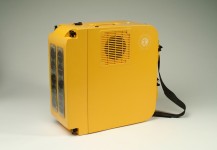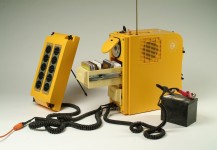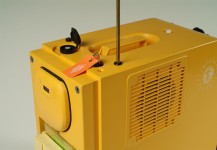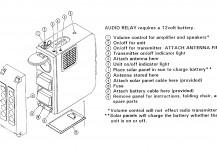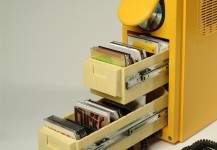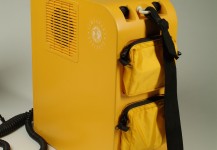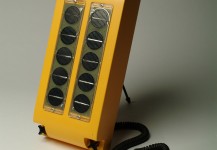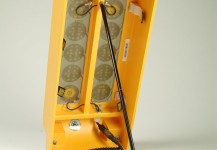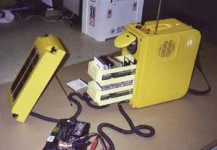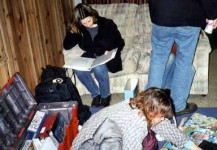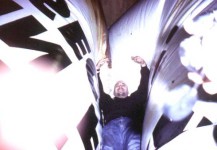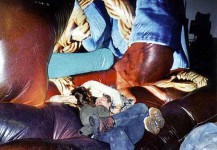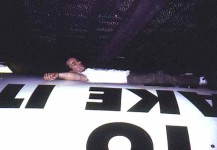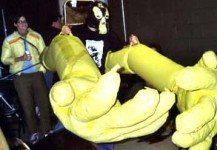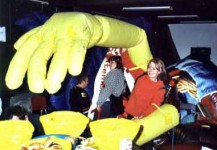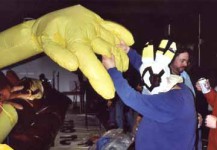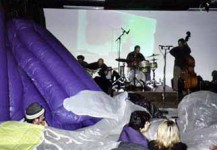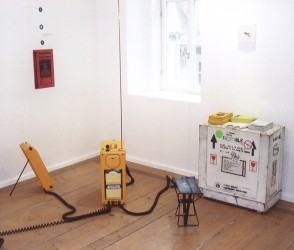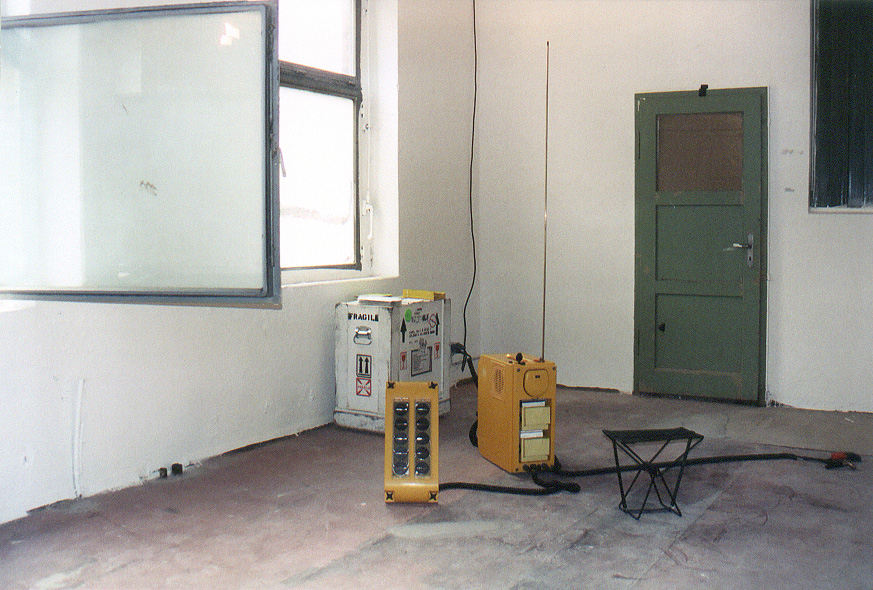Audio Relay (2002)
CHICAGO CONTRIBUTORS
Eleanor Balson, Greg Jacobsen and Thyme Jones, Frump! Strumpet! Strife!
A delightful radio program that aired on WZRD, CHICAGO 88.3 from March-October 2000. The show featured 3 swishy sophisticates (Eleanor Balson, Gregory Jacobsen, Thymme Jones) and their very special friends. Expect no bad ‘radio theatre’! Only expect to have your night ruined! NO FUN HERE! No ‘Laughs’! No, er, ‘Gags’! …but we have been practicing our smiles!
Mark Booth, Spanish Still Life – Part 4 (365 Days Renamed) (58:00)
Recorded live in performance on October 18, 2002 at 1926 Gallery, Chicago, Illinois, USA.
With:
Lucy Baldwin – voice
Mark Booth – voice
Daniel Borzutzky – voice
John Corbett – voice, slide guitar, prepared guitar, bells
Matthew Goulish – voice
Sarah Guernsey – voice
Lin Hixson – voice
Charles King – electronics, turntable, short-wave
Lou Mallozzi – voice
Kathleen Odell – voice
Terri Kapsalis – voice, violin, accordian
M. W. Burns, Observer, 2001
“Observer” is a verbal description which rapidly shifts from one viewer’s perspective to the next through the eyes of the person last seen. The listener is caught up in a potentially endless description of passing glances:
…seeing a critic entering a museum and watching a ticket taker who was observing a curator noticing a visitor examining a guard seated at a surveillance monitor spotting a truck driver at a loading dock who was looking into an apartment window at a student on a computer viewing a video stream from a night club seeing a dancer glancing at a bouncer watching a drinker staring into the eyes of a date noticing the bar tender peering over the tap at a DJ looking around a loudspeaker at a sailor watching a comedian glance back with eyes fixed on a band member seeing a singer catching sight of a groupie leaving the club and spotting a television personality climbing into a cab while observing the neck of a driver who was examining a pedestrian…
Paul Dickinson, Sleep Talk Recordings, Volume I, 1986 – 2000
Paul Dickinson talks in his sleep. Since 1986, he has documented this phenomenon with the aid of voice-activated recorders. This CD is a compilation of recordingcollected from 1986 – 2000: ninety-nine hits spanning a fourteen-year period.
A complete transcript is provided in the accompanying 12-page booklet.
Gabriel Fowler, Songs Suspected of Satanic Back Masking, 2002
The term “Back masking” refers to messages hidden within musical recordings, which can be heard only when playing the recording backward. Many claims have been made regarding the legitimacy of back masked messages, and most arguments rest on speculations about the intentionality of the performer. Some believe the messages are placed purposefully by musicians or technicians, some believe the messages appear by accident, and some believe the messages are placed by supernatural or subconscious forces. They reality includes all of the above, and can be separated into to prevailing categories: engineered reversals and phonetic reversals.
Engineered reversals are created purposefully in the recording studio by musicians and technicians.Information is recorded normally, and is intentionally reversed and incorporated into the final “mix.” When the finished recording is played normally,the information is abstract and indecipherable; when the entire recording is played backwards, the reversal is clearly audible and the primary performance is abstract and indecipherable. Some examples include “Darling Nikki”by Prince and “Fire is High” by Electric Light Orchestra.
In contrast, phonetic reversals result from subjective interpretation of reversed phonemes. This interpretative process allows for accident and influence from subconscious: the music is played backwards, and listeners strain to discern recognizable words. This method of interpretation is highly dependent on the predisposition of the listener, who is usually looking for particular type of content.
The selections on this CD are all reversed and are presented in their entirety, allowing the listener to discover backward content at their leisure. The selections represent a “greatest hits” of back masking, and were selected in response to widespread claims alleging backward content.
Melinda Fries, ausgang.com presents: Violent Things, 2003
27 people answer the question: “What is the most violent thing you’ve ever done?”
The majority of participants have chosen to remain anonymous so no names are included.
Melinda Fries: melinda@ausgang.com
Rob Kelly & Zena Sakowski + Temporary Services | Midwest Side Story Soundtrack, 2002
We have created a compact disc featuring remixes of the soundtrack from West Side Story. Our public demonstrations of our inflatable forms may be accompanied by this CD, which updates Sondheim’s lyrics by incorporating parallel ideas in the West Coast gangsta rap of N.W.A. along with a kitchen sink of other sonic turmoil.
Kathleen Kranack, GOOD ADVICE: Best of Free Relationship Advice, 1999-2000
In search of an explanation and a solution for my own relationship problems, I began the Free Relationship Advice telephone-based hotline in December 1999. My original intentions were to create a forum for exploring the language of American self-help culture as a (im)practical approach to harnessing gender differences.
Updated daily (well, almost daily), snippets of personal conversations, infomercials, talk shows, motivational literature, and other cultural artifacts were recorded as voicemail messages that were accessible to listeners when they called the hotline. Thousands of cards advertising the phone number were distributed publicly left in taxicabs, on the subway, in restrooms, by payphones. Callers were invited to leave messages, questions, and comments after the tone. As the project gained momentum, Free Relationship Advice took an unexpected turn.
SURPRISE! Citizens with real, immediate problems?people not necessarily interested in theatrical performances and cultural analysis were picking up the cards and needed Free Relationship Advice! Though I began as a satirist rather than relationship expert, I felt obligated to lessen my focus on critiquing self-help culture and instead shifted my attention, ironically, to finding valuable information hidden within teensploitation shows and between the pages of self-help books.
After providing advice for approximately ten months, I decided to take a break from Free Relationship Advice in October 2000. I hope to re-launch the project in the future as a 1-800 number.
Lucky Pierre, Lucky Pierre Speaks Urban Format Radio, 24 CDs, 2002
Lucky Pierre and 40+ friends listen to B-96 on headphones for twenty-four hours straight. We repeat everything we hear into a microphone and record twenty-four CDs.
Brennan McGaffey, Project Citizens Band, Mood Control for 27 Mhz, April 2000
This project was a month long broadcast over CB radio using prerecorded tones designed to be mood altering. Four different tones responded to common emotions experienced at the scheduled time of day. These tones were transmitted 4 times a day for a 5-minute duration, creating a sedativeor stimulating affect. There were no voice-overs or songs. The broadcast was amplified to 225 watts to increase the chance for shortwave skip and reception over long distances.
Schedule: 8:30am morning coffee, 2:30pm afternoon break, 5:30pm evening/rush hour, 10:30pm bedtime/rest-stop
Red Cabinet Theater
Service Anxiety, Oppression in Constellation – an unreleased record from Service Anxiety
Personnel:
Travis Anderson: Bass
Dave Grant: Vocals, Trumpet
Jared Sheldon: Drums
Woody Sullender: Guitar, Electronics, Banjo
Service Anxiety is a hardcore band from Chicago. Our choices for organizing sounds into rock and roll music reflect similar structures we find in the world. We are struggling to balance our desire for true freedom with our need to live within a larger social network (free improvisation vs. hardcore; illegal venue vs. legal venue). Still, methods of organizing often follow preexisting molds to maximize predetermined effects (the dancy verse; another Food Not Bombs).
We consider some formulas within no wave and hardcore punk of the early 80s to be quite efficient for rocking appropriate audiences. However, for such highly politicized genres, they are too often the most conservative of music forms. We strive to maintain the energy of these sub-genres while also remaining conscious and critical of their social and musical structures.
Our work attempts to serve a more pragmatic purpose of offering support and comfort to anyone who desires freedom from fascism within all aspects of public and private life. A transmission of energy-a statement of solidarity.
Dave (vocals) formerly sang for the hc bands Action Patrol and the Episode. Woody (guitar) has helped organize the Transmissions experimental music festivals since their inception in 1998 and runs the tiny Dead CEO label.”
Jenny Gräf Sheppard, The Guitars Project (audio component, Iconic Distortions), 2003
The Guitars Project sound piece is constructed from the recordings made during a project involving six electric guitars and six older women with Alzheimer’s or other age-related disabilities. Using experimental approaches the women generate sounds on the electric guitars, finding ways in which to interact with what is predominantly a male, youth and pop associated object. Meeting for five months twice a week the women each found her own way of interacting with the instrument. The symbol of the electric guitar and all it suggests is what I was interested in placing within the context of the image of the older woman. The older woman and all she signifies seems to be in conflict with the symbol of the electric guitar. This project is an exploration of such multi-valiancy.
The other issues that compelled me to start this project was the role memory plays in the perception of sound. How does one whose memory does not function optimally experience or construct sound. Would the temporal reality of a person with Alzheimer’s be heard in the sounds she produces? Also, with the problems many women have communicating verbally due to Alzheimer’s, what role would sound play to form a group dynamic? The play between the women in this group served to make up for much of the dynamic that is lost in groups of women during old age.
I composed Iconic Distortions from over 20 hours of recordings I made while working with the women in The Guitars Project. Many of the sounds have been manipulated, looped,distorted or mixed. It gives a false picture of what these women are capable of on their own. It is a re-animation of the sound produced by them and a map of suggested connections, imagined or real. It is a fantasy portrait of the group.
As the vinyl picture disc (the final form the sound piece will exist in) suggests with its idealized portrait of Alice with her guitar, it is the making of a new kind of icon, (and icons are always part truth, part fiction). One that I need to exist.
Deborah Stratman, In Order Not to Be Here – Radio Version
I excerpted and rearranged the soundtrack from my video “In Order Not To Be Here” (2002, 16mm, 33 min.). Audio sources include location ambiance, CNN news reportage, police scanners, helicopter pursuits, and electronic music by Kevin Drumm. The original film is an uncompromising look at the ways privacy, safety, convenience and surveillance determine our environment. Shot entirely at night, it confronts the hermetic nature of white-collar communities, dissecting the fear behind contemporary suburban design.
Deborah Stratman and Jacob Ross, Power/Exchange – FM Transmission Loop
Power/Exchange is an unconventional survey of the infrastructure and architecture of transmission. In particular, the transmission of electric power and the transmission of human thought a.k.a. the telecommunications industry.
The Power/Exchange Tower is publicly accessible, user-operated radio tower being erected in Wendover NV/UT. The user operates the tower via a self-standing operations kiosk at the tower base. By turning a notched dial, the user may choose to receive one of 10 pre-determined local frequencies:
1. AC power transmission (60 Hz – VLF)
2. Citizen’s Band (27.185 MHz)
3. NOAA weather (162.4750 MHz)
4. Local Police (154.7500, 461.3500, 461.9500, 866.7875 MHz)
5. Union Pacific Railroad (160.1100 – 161.5650 MHz)
6. Taco Burger Drive Thru Window (TBA)
7. Flyover & Airport Traffic (121.500, 122.100, 123.600, 135.075 MHZ)
8. Tones and Morse (155.1300, 855.2125, 952.0125, 954.5500 MHz)
9. Local Casinos (461.0250, 461.2750, 461.4000, 461.4250 MHz)
10. Atomic Clock (10 MHz – shortwave)
The user may also choose to transmit signals onto Citizen’s Band. He/She will be able to communicate with other CB users by speaking into a microphone embedded into the kiosk while pressing the TRANSMIT button.
Every time a user turns on the kiosk POWER (a wind generator supplies a battery bank wiredto a timer), a pre-recorded loop will be broadcast on to low wattage FM. The loop functions as a kind of PSA, and relays, among other things, the following information: “Frequency allocation is a federal construct. Corporate conglomeration of media leads to a conglomeration of ideas. Advocate for a diversification of voices. Low power to the people.”
The recording lasts 60 seconds before repeating. It will continue looping for 10 minutes at which point the kiosk power automatically switches off until the user presses POWER again, or until the next user visits the tower.
An informational Power/Exchange Booklet is dispensed at the tower site, at various places around Wendover, at the Center For Land Use Interpretation in Los Angeles, and at Quimby’s in Chicago.
Tiny Hairs, OSLO
1 – pipsqueek: 2001
2 – salted fruit: 2001
3 – she was reading an obscure novel by my favorite author but our love never bloomed: 2002
4 – 35 syllable system: 2002
TINY HAIRS is:
MarkBooth
JohnDevylder
Chuck King
Jim Lutes
Jonathan Liss
Peter Rosenbloom
Daniel Tucker et al, Fuck the Police (Hits for the Streets) the CD, 2002
It was around 1988 that the Compton based crew Niggaz With Attitude (NWA) came out with their track “Fuck the Police.” “Fuck the Police” threw NWA into mass popularity and simultaneously set the blueprint for the West Coast’s “gangsta” hiphop politics and propelled the issue of police abuse and brutality into the spotlight.
The problem of police must be understood in a larger social, economic and political context. The police are the armed shock troops of the State. The U.S. government has a conscious policy of dealing with most social problems by criminalizing people. Drugs a problem? Make their use, sale, and possession illegal. Homelessness a problem? Make sleeping on the street, squatting abandoned buildings, eating out of dumpster’s illegal. All these “solutions” mean more money for police and prisons and little or nothing for policies and programs that promote social, economic and racial justice for people of color. We get cops instead of food and meaningful work, prisons when we need a place to sleep.
Major industries now count on the quasi-slave labor available in prisons and as de-industrialization has ravished much of the economic base of the country, prisons have become the only economic option offered to communities in need. As community based organizations, civil rights / human rights organizations and public interest advocacy groups struggle against police brutality and misconduct, it is essential to understand that huge numbers of people now have a vested interest, a critical economic stake in expanding police forces and the prison / jail industrial complex.
Our goal must be nothing short of creating a just, humane and peaceful society. Fuck The Police (Hits for the streets) the CD was created as a celebration of speaking out against the cops and to document some of the widespread influence that the song “Fuck the Police” has had. And why wouldn’t it, everyone hates the cops, right?
All songs were taken without permission from the Internet or recorded specifically for this project. Again, fuck the police and think about it. Get involved; check out Stolenlives.org and other police brutality projects.
CD includes tracks by NWA, the Imagine Agents, Ryan Thurbur, Warren Johnston, Dope and several others…
John Wanzel, Pear
Pear is an experimental sound piece for radio that consists of a series of narrative and sonic vignettes. The piece is concerned in general with how despair and desire effect the creation of a self that is mediated by personal and cultural experience. The text material for the project was produced by answers to fill-in-the-blank workbooks, as well as writings influenced by sections of St. Augustine’s Confession, Soren Kierkegaard’s A Sickness Unto Death, and Sophocles’ Oedipus Rex, in light of genetic engineering, a psycho-biography, along with language and computer systems.
Written and directed by John Wanzel Featuring the Voices of Anna Benavides, Brian Taylor, and John Wanzel. All sounds produced by John Wanzel. Mixed by JohnWanzel and Pete Wenger. Recorded / Engineered by Pete Wenger at Experimental Sound Studio (Chicago, IL)
Dave Whitman + Temporary Services, Dave’s Stories, 2002
Dave Whitman has been homeless for over fifteen years. We first met Dave when he started attending the exhibitions and projects we presented in our former office space in downtown Chicago. Dave continued to visit us informally and all of us gradually got to know him.
We developed a friendship with Dave and found him to be unusually generous, ethical, and trustworthy. He often kept us company while we maintained office hours during exhibitions – frequently engaging visitors in discussions about the work on view.
Salem, of TS, gave Dave a tape recorder and provided him with replacement cassettes and batteries. The recorder allowed Dave to document the incredible stories he’d been telling us. It gave him a space to recount his many astute observations about how public space is regulated, unusual social behavior, and his endlessly revealing and entertaining stories about other homeless people.
Dave recorded over six hours of stories for us. Here are just a few. We hope you enjoy this introduction to one of our city’s dearest urban nomads.
All of the tracks from this CD are on this page.
SAN FRANCISCO CONTRIBUTORS
*The group It Can Change and our friends helped out in a big way in compiling material for Audio Relay’s visit to San Francisco. Thanks!
Tommy Becker, And down came the mighty sword
This compilation CD was produced in a large walk-in closet over the period of two years. It includes short disappearing narratives, heartfelt scores of power and bits and pieces of blubbering. As the green turned, turned to green-yellow, beneath the war torn bodies that crows now hopped across, a space opened for the soil to rise and show it’s ugly underpinnings. The warrior, faced with an axe to the brow, cared little, but the ripe bacteria that had accumulated from the dead slowly slipped their way into his battered toe nail. In a matter of a month he, the most valiant, would be placing his foot on the block and down, down would come the mighty sword.
Flamethrower, 2003
Swansong of a drowning machine: manic rhythms, elegiac melodies, monolithic bass welling up atomized, over driven, a temperamental eddy of attenuated beats combed in waves of static, echolocation of recondite memories submerged ‘neath shipwrecked hulk of halcyon days, salvaged in gurgling synthesis of halting syncopation and interjections ruptured as if with the bends.
Hammer and Throck, Hammer and Throck, 2003
The earthquake at the house taken apart by Oakland’s Hammer and the basic rule of Throck is the therapy of atonal impact, of the one. Theatre of cruelty, Ferocity, Virtuous.
Trevor Paglen, Security Housing Unit, 2002
The recordings on this CD were made in the Security Housing Unit (SHU) at Pelican Bay State Prison, one of the nation’s premiere “supermax” prisons. Built in 1989 at a cost of $277.5 million, Pelican Bay represents the apex of California incarceration. The SHU units at Pelican Bay are designed for maximum isolation: prisoners are kept in small cells 23 hours a day and automated doors ensure an absolute minimum of interaction with other human beings.
Animated by Quaker notions of the rehabilitative power of reflection and introspection, solitary confinement began in American prisons in 1829. The practice was largely discontinued when it became evident that extended periods of solitary confinement often led to mental breakdown. Despite repeated court rulings of Eighth-Amendment violations at Pelican Bay, the supermax model of incarceration has grown dramatically over the last ten years as American prison policy has shifted from a philosophy of rehabilitation to one of punishment and retribution. When it was built, Pelican Bay was one of the first prisons to regularly keep inmates in isolation for more than 30 days at a time. There are now an estimated 20,000 people living in 57 supermax units across 42 states.*
These recordings are part of a large project undertaken by Trevor Paglen with various prison-activist groups about the everyday geographies of California incarceration. More information about the project is available at www.paglen.com.
* Source: A Question of Control by Angela Davis and Cassandra Shaylor. San Francisco Chronicle, April 9, 2000.
Margaritta Ranjii, Eviction Notice “A,B,C”, 2003
Starving, immortal eskimo awakes from 100 years of hibernation, walks the ice in search of living flesh to sustain his weary body, but the world has undergone a nuclear apocalypse and he is the only one left save for one giant, fierce polar bear that also happens to be immortal and starving. muted gusts of blizzard breath; strident and distorted, loping and stumbling across arctic wastes, punctuated by keening arcs of atavistic bloodlust: you must fight to live.
PORTLAND CONTRIBUTORS
Peter Moran, Guitar Required
“If you’re interested in purity, listen to Napalm Death.” John Zorn
If you’re reading this, you may be listening to the accompanying compact disk, which consists of music culled from several “Learn How To Play…” instructional CDs. These recordings are usually tucked in plastic sleeves in the back of songbooks, and frequently found in music stores, schools, libraries, and possibly your home.
The breadth of sounds available within the genre is enormous. The music, and the literature it supplements, can reveal a surprising degree of humor and self-awareness, while even hinting at the songs and pedagogy popular in a given era. Out of context, the results are often astounding sonic artifacts.
Following their original intent, these recordings distinctly ask the listener to participate actively in their realization. This can be unusual especially when we leave sampled music circles. If this music’s ultimate aim is education, its end must be musical purity: music without inflection or embellishments. In this sense, itss impervious to criticism. By traditional standards at least, it’s always played perfectly.
Besides playing along, the listener could invent new lyrics to these songs.* Personally, I also enjoy listening passively. A comforting host usually presents the music. And even with implicit designs to discipline the listener (enough to practice regularly, possibly to encourage purchase of Volume Two in a series), this form stands opposite most radio programming presently heard on the air. While commercial stations may broadcast similar material, by default they limit the listener’s participation with it.
Strictly to facilitate the given purpose of these recordings in some manner, I restricted the selections on this CD to acoustic guitar tracks. If the listener is so inclined, a detailed listing of the music on this CD is available at www.geocities.com/guitarrequired for further inquiry.
*Andrew Bar, from the Children’s Hour, introduced me to this form of expression.
Red76 Arts Group
WEIMAR CONTRIBUTORS
Peter Redgrave, The Glass Hat Proposal 1, 2003
This is the initial proposal for a fun house that Smelling Salt Amusements intends to build. Presented here are digital simulations of some of the interior environments planned and orchestrations, which will be found throughout the house. There are also demonstrations of actual soundscapes and an archival recording that inspired the project.
ITINERARY
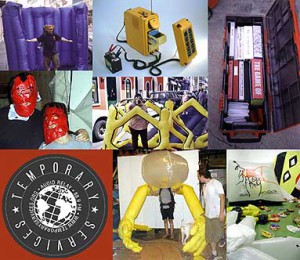
Winter Services — 6Odum, 2116 West Chicago Avenue, Chicago, IL, December 7, 7:00 – 11:30 pm, 2002
This is a one night event with performances celebrating the launch of Audio Relay, our autonomous radio station and audio archive built by Brennan McGaffey. The event also includes Binder Archives (see below) and a presentation of inflatable things (wall, police officer, giant billboard and more) from our Midwest Side Story project with Rob Kelly and Zena Sakowski. There will be a slide show from our actions in Puerto Rico with the inflatables. We will be giving away several booklets. Free booklets include: a manual for Audio Relay, a schedule of the performances and contents of the Audio Relay, Midwest Side Story booklet and a supplement to that project.
This event is FREE. FREE masks handed out at the door. FREE food and beer provided.
Performances By:
Red Cabinet Theater (with Margaret Baldwin, and Peoples Republic of Delicious Food members Nathan Peck and Ralph Barton)
The First Plenary Session of the Revolutionary Party of Saturn (featuring members of Service Anxiety)
Tiny Hairs
The Audio Relay will house and broadcast work during the event by:
Eleanor Balson, Greg Jacobsen and Thyme Jones
Mark Booth
M.W. Burns
Gabriel Fowler
Rob Kelly and Zena Sakowski + Temporary Services
Kathleen Kranack
Lucky Pierre
Brennan McGaffey
Red Cabinet Theater
Service Anxiety
Deborah Stratman and Jacob Ross
Tiny Hairs
Daniel Tucker
John Wanzel
Dave Whitman + Temporary Services
Various projects — Get rid of yourself, Autonomous Cultural Center, Weimar and Halle 14, Leipzig, July 26 – October 12, 2003
At ACC we presented: Aesthetic Analysis of Human Groupings, Public Sculpture Opinion Poll, and a large survey of our publications.
At Halle 14 we presented: Prisoners’ Inventions.
Binder Archives and Audio Relay moved back and forth between Weimar and Leipzig.
Get Rid of Yourself, e-flux Press Release
